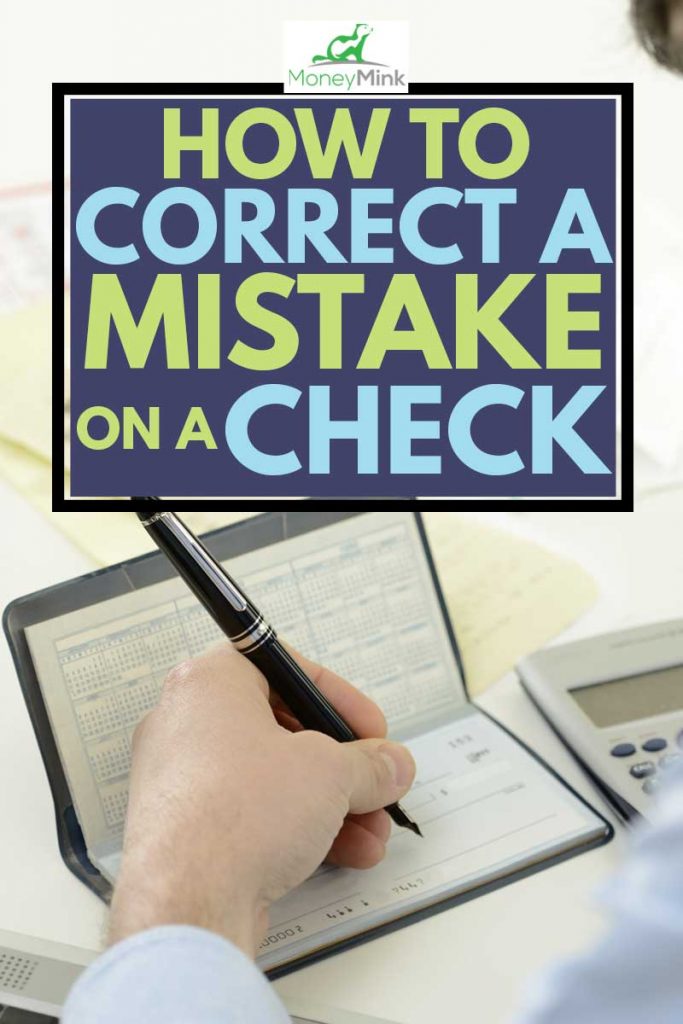Check writing may not be as popular as it once was, but that only means more questions about how to fix mistakes when you are filling one in. Fortunately, we've sourced expert answers to all your check-writing questions.
In general, you can correct some mistakes on a check without affecting the validity of the document. For example,
- You can amend your address or phone number on checks with old information
- You may adjust a date on a check if you sign your initials next to the correction
- You can rewrite a numerical amount if you sign next to the correction
- You may deposit a check with your name misspelled if you sign the check with the misspelling and add the correct spelling
However, it is up to the discretion of your bank whether they accept any check with a correction. To prevent fraud, many banks have strict rules about when and how you can make changes to your checks.

Some specifics depend on your bank or financial institution's rules. So, there is a lot more to know about how—and when—to correct mistakes on your checks.
Can You Correct a Date on a Check?
Many banks will allow you to correct mistakes by crossing through the error (with a single strike-through line), writing the correction, and initialing the change.
Dates, however, are variable depending on your financial institution. Especially if the original date looks as if it was from more than six months prior, the bank might refuse to honor it because it is stale-dated.
A stale-dated check means one that may not be honored because it wasn't cashed or deposited within a set amount of time. Timelines vary, but six months (180 days) is typical for personal bank accounts.
At the same time, many banks accept undated checks—or you can enter the current date yourself.
Can You Deposit a Check with a Misspelled Name?
The short answer on whether you can deposit a check with a misspelled name depends on a few factors. First, it depends on your bank—some are more strict than others when it comes to the preciseness of information on checks and other paperwork.
But whether you can deposit a misspelled check also depends on how the error comes across. If someone wrote you a check and spelled your name wrong—maybe it's off by a letter or two—there may not be a problem.
In contrast, if you sign your name incorrectly, that may be a warning sign for the bank that someone is attempting fraud. Plus, if you are depositing a check where someone misspelled your name, you may need to acknowledge the misspelling by signing with the error—more on that below.
Of course, if you order checks and your name arrives misspelled, the bank may process the checks anyway until you can order replacements. In many cases, crossing out such information and fixing it (with your initials) may suffice in the meantime.
Can You Deposit Checks with the Wrong Address?
For most banks, incorrect address or phone number information is no big deal. You can correct your address, phone number, or name (as long as your legal name is what the bank currently has on file) on a check without consequence.
The best practice for making any correction is striking through the error, writing in the correction, and putting your initials in the vicinity.
Keep in mind that you should never use white-out to fix any mistakes, however, as that can be indicative of a fraud attempt.
What Happens If You Write Two Different Amounts on a Check?
When you write a check, you'll write both a numerical amount and that amount in written numbers. But if the two areas don't match, what happens?
Keep in mind that the line where you write out the check amount is called the "legal line." The place where the numerical value goes is the "courtesy box" and only confirms the total in a way that may be easier to read.
According to the Consumer Financial Protection Bureau, the spelled-out words explain the legal amount the check is worth.
If you receive a check with two different amounts, your bank might have special rules for processing it. It's usually in your best interest to ask the person or business who wrote the check for a replacement that's accurate.
Is a Check Valid Without a Numerical Amount?
While contradicting amounts may not be an issue, what about an entirely blank courtesy box? Technically, anyone can write in the appropriate amount, which makes this point moot.
If you receive a check without a numerical amount, you can write it in yourself. However, depending on the source of the check, it could bounce if the amount is incorrect.
If you write a check and forget the numerical amount, the recipient could also write it in. You may have difficulty proving fraud if the person alters the check from the amount you intended, however.
Of course, if no one writes in the missing amount, the bank can choose to reject to cash or deposit it. However, this varies based on your financial institution.
How Do You Correct a Check Amount?
For mistakes made when writing the value words on your check, there's no easy fix. You'll need to void the check and write a new one.
Correcting the numeric amount is straightforward: strike through the incorrect amount, write the appropriate numbers above that and circle the proper amount. Be sure to initial the change, too.
What Happens If You Sign a Check Wrong?
Signing a check can go wrong in many ways. Maybe you write your maiden name instead of your married one, or perhaps you sign with a nickname instead of the full name that's on your bank account.
Are you concerned about an incorrect signature on your credit or debit card? Find more information on the topic in our related post, Credit or Debit Card Signature Smudge—What to Do?
But with most financial institutions, the signature on the check is the most crucial aspect. Without a signature, a check is not valid. So, if the signature is wrong, that could suggest to the bank that someone is trying to commit fraud.
How Do You Correct a Mistake When Endorsing a Check?
Endorsing a check refers to signing the back of it. Consumers should endorse checks because this is the step required to transfer the funds to the bank legally. However, another reason to endorse checks is that it enhances the security of your funds. You can write "for deposit only" and even include your account number (plus signature) to ensure no one else is able to use your check if you happen to lose it.
A mistake on the endorsement area of a check can present issues if your bank is strict on its deposit rules.
For example, since your name must match the "Pay to the Order Of" section, if someone fills out your name improperly, you must endorse it with the incorrect spelling. You can also write the correct signature in the endorsement area, too.
Unfortunately, if you decide to change an endorsement—such as swapping from "for deposit only" to another endorsement type, crossing it out will not work. Technically, there is no way to undo an endorsement. That said, your bank may be laxer about adhering to their own rules, so you could get away with making a change.
Thinking about other banking issues beyond checks? See When Should I Cash In EE Savings Bonds? for more information.
Can You Deposit a Check Without Signing the Back?
Some banks are sticklers for rules, but in most cases, you can deposit a check with signing the back (endorsing it). For ATM or mobile deposits, you won't know whether the check is valid without the endorsement until the bank processes it.
When you visit a bank branch, however, the teller will likely request your signature on the endorsement line before depositing or cashing the check. Visiting the bank in-person is often the best way to circumvent any check-writing issues. Of course, for those on the issuing end of the check process, you may not know there's a problem until your check recipient reports it to you.
Regardless, the bank has the final say when it comes to whether your check is valid or not. If you have questions, it's wise to call your bank. Or, you can go in to ask about the policies and guidelines.
In many cases, financial institutions would rather err on the side of caution—which could mean denying a check that seems suspicious, even if it was a simple error that raised red flags.



